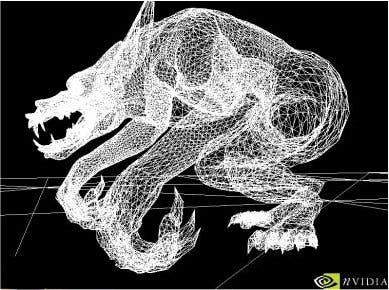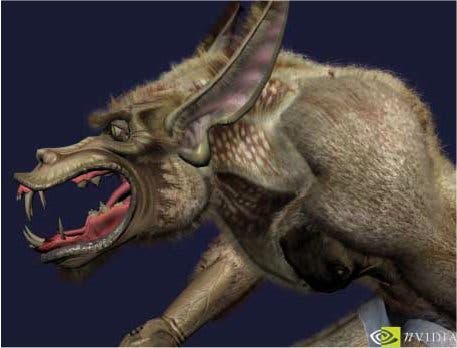GeForce 4 Titanium 4600
Review - the fastest video card company on the planet is going for its guns again
- NVIDIAPrice - ~£300

She's Back
NVIDIA's GeForce 4 Titanium 4600 (or NV25) may have started life as one of the worst kept secrets in the hardware industry, but now it's on the market it easily steals the crown for top video card from its sibling the GeForce 3 Titanium 500 and relegates competing cards to the ranks of also-rans. You can argue about the futility of the naming convention all you want, but in terms of raw power the Ti4600 boasts a 300MHz GPU and 128Mb of the fastest memory, clocked at 650MHz. Some card manufacturers - Gainward is one - have squeezed even more out of the chip, ramping up those clock speeds to improve performance. At its peak the Ti4600 can shovel 10.4Gbyte/sec. That's an improvement of more than 25% over the GeForce 3 Ti500 and more than a third faster than the Ti200, meaning that while the Radeon 8500's memory subsystem can outperform the Ti500, it's no match for the heady heights of the GeForce 4. Coupled with an array of new features (including improved anti-aliasing and the new nfiniteFX II engine), this is the second card in a row to improve on the original GF3 formula. But ultimately the question still remains, why would anybody buy this card? The most important thing to remember about NVIDIA's flagship graphics card is that once again early adopters are paying for the privilege of a few tech demos and perhaps the odd game next year. Existing GeForce 3 graphics cards are already capable of rendering virtually anything developers can throw at them, and even on maximum settings the original GeForce 3 board barely breaks into a sweat for cutting edge games like Medal of Honor : Allied Assault and Aquanox. Consumers could pay up to £150 as a premium on top of the cost of a regular graphics card, and yet there is no present-day application to justify that investment.

Déjà vu…
In terms of what's new, it's the same old story. With each new video card from NVIDIA we're forced to reassess the boundaries of what's possible on a PC. For example, as NVIDIA's press pouch informed me, the new nfiniteFX II engine sports dual vertex shaders, advanced pixel shader pipelines, 3D textures, shadow buffers and z-correct bump mapping, all of which can combine to render high quality hair and fur, arguably for the first time with any reliability. Thirteen years ago, we're told, it took a network of IBM mainframes made up of twelve 3090 processors and four 3081 processors two hours to draw a single frame of a fuzzy bear. GeForce 4 Titanium 4600 can do it in real-time. Wolfman up there contains over 100,000 polygons, more than 20 times the complexity of previous projects. Wolfman uses eight concentric fur shells, and the colour and density of the fur is controlled using a separate texture map that covers the entire body. This gives the fur its distinct look, rather than a uniform pattern. Wolfman has a completely skinned animation with a 61-bone skeleton, of a complexity equal to that used for models in movie special effects. Each vertex of the skin, fur layers and fin geometry are deformed in real-time to match the movement of the underlying skeleton, with the nfiniteFX II engine handling the vertex deformation for each of the right layers. Another aspect of Wolfman is the computationally expensive anisotropic lighting - the way his hair and fur reflect light more in some directions than others. The nfiniteFX II engine has advanced pixel shaders to deliver anisotropic lighting to the Wolfman while maintaining fast frame rates.

Hair-raising new features
Apart from realistic hair and fur, GeForce 4 promises superior antialiasing via something called Accuview Antialiasing. Accuview is a fully integrated multisampling solution, which reduces the strain on the GPU by providing wider internal data paths to handle the extra pixels. GPUs can compute these 'virtual pixels' or additional samples at full speed. Tests with a GeForce 4 Ti 4600 indicate that the card can handle 2x antialiasing in 1024x768 at 32-bit colour depth at the same speed that the GeForce 3 Ti500 board runs without the antialiasing. Accuview offers several modes including a new 4XS mode that delivers improved subpixel coverage and better texture quality. Accuview also incorporates anisotropic filtering. Furthermore on the features front, after the success of NVIDIA's Lightspeed Memory Architecture (LMA) on the GeForce 3, LMA II has been unveiled as its successor to help compensate for memory bandwidth restrictions. It introduces a number of new technologies to maximize bandwidth efficiency, combining new features with old. Thanks to a new Video Processing Engine, NVIDIA is also offering world class DVD playback to boot with advanced adaptive de-interlacing. Top line Ti 4600 offerings will also ship with ViVo, as well as DVI and VGA output. Rounding out the new features we have the nView multi-display technology. Thanks to the Ti4600's DVI output (and the application of a DVI-VGA dongle if you don't have a flat panel), multiple monitor support is bundled into the package. Unlike our GeForce 4 MX 440 card, we had no trouble with multi-monitor out under Windows Millennium, 2000 and XP Pro, and running a single desktop across two monitors is greatly assisted by the nView software, which shunts dialogue boxes to their respective windows, remembers program locations (if those programs are willing to play ball) and tweaks performance settings (such as cutting out unnecessary frames of Windows GUI animation).

Picture Perfect
A host of new features then, but the big question is one of performance. We clocked the GeForce 3 Ti500 at 7,500 3D Marks. Astounding us once more, the Ti4600 managed 9,138 on the same Athlon XP system. Like the Ti500, we couldn't find anything that really made the card break a sweat. Nothing stretched it short of whacking the resolution up to 1600x1200 in 32-bit colour and enabling 4xFSAA. On the functionality front one can hardly complain. Installing the card was a breeze - I just whipped off the side of my PC's case, pulled out the old card and stuck in the new one. The Ti4600 is a lot larger than the Ti500, and if I ever want to install any more memory I ill have to remove it to get at the memory slots clips, but generally speaking there were no problems. Watch out if you have a small case though. Cooling is amply dealt with on our reference board too. As you can see, NVIDIA has furnished the card with an enormous, colourfully decorated heatsink/fan unit, which adequately cools the monstrous card. In fact, the only complaint we really have with the Ti4600 is that the refresh rate issue (which, without the use of an external program, seems to condemn users to the Windows default 60Hz whenever they fire up a game) has yet to be resolved. It's worth considering that this is a Windows problem, inherent to 2000 and XP, and that ATI's cards also suffer from it, but with third party fixes on the market, why won't one or other of the pair stick their neck out and do something?
Conclusion
With the GeForce 4 Ti4600 NVIDIA has created a monstrous icon for the video card industry. On the marketing front it's not a true successor to GeForce 3. NVIDIA seems to like releasing one technological revamp every couple of years and padding out the interim with speed bumps. If you own a GeForce 3, I suppose the point is that you ought to wait for the GeForce 5 before you really consider upgrading. But if you're falling behind and want to keep yourself in games for a couple of years, the Ti4600 represents the pinnacle. Of pricing and performance.
-

